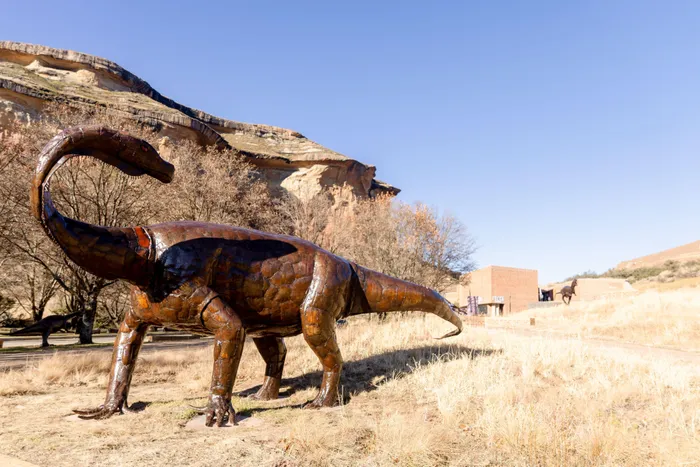
The Kgodumodumo Dinosaur Interpretation Centre is a unique interactive facility in the Golden Gate National Park in the Free State.
Image: Department of Tourism / Instagram
ONE of the worst days in the history of life on Earth started like any other.
Herds of hadrosaurs with huge head crests and duck bills roamed ancient New Mexico for plants to eat, making sure not to end up underfoot a long-necked titanosaur or, worse, in the jaws of a tyrannosaur.
None of them knew that a space rock more than six miles wide was hurtling toward Earth and about to kill them all.
The asteroid impact triggered one of the planet’s worst mass-extinction events, wiping out all dinosaurs but birds. Out of the ashes rose mammals, including ones curious enough 66 million years later to scrutinize the bones dinosaurs left behind.
Yet paleontologists still debate what exactly happened in the years before the impact: Did these reptilian rulers go extinct suddenly due to the cosmic collision? Or were dinosaurs already in decline before the impact, with the asteroid merely delivering the knockout punch?
New precise dating techniques of a century-old fossil site in New Mexico are opening a window into the years before the collision. Dinosaurs were flourishing, not foundering, as kings of the Cretaceous right up until the end, according to the new study.
“It doesn’t seem like they were doomed to extinction,” said Dan Peppe, a Baylor University paleontologist who co-wrote a paper published Thursday in the journal Science. “They were doing quite well. They’re abundant and diverse all the way up to the end."
When the asteroid struck Earth, a cloud of dust laced with iridium, a metal common in meteorites, blanketed the planet. Paleontologists use that telltale layer of atoms from space embedded in clay to mark the end of the age of dinosaurs in the rock record.
The Ojo Alamo Formation in northwest New Mexico, which has been explored since at least the 1910s, has yielded plenty of fossils. But the iridium layer there eroded away long ago, making it difficult to precisely date those dinosaurs.
“The ages of these rocks were contentious for a really long time,” said Andrew Flynn, a New Mexico State University paleontologist who led the study.
So Flynn, Peppe and their colleagues turned to two high-tech dating techniques to nail down the rocks’s age.
First, they measured magnetic fingerprints left in fossilized soils and sandstones in New Mexico. Throughout Earth’s history, the direction of the planet’s magnetic field has flipped hundreds of times, leaving subtle impressions in rocks. Scientists know when the flips happened, allowing them to clock when the rocks were deposited.
Next, they measured the amount of argon locked in the crystals in sandstones. The element builds up in crystals at a known rate as potassium undergoes radioactive decay, giving scientists another way to date the site.
Combining the two techniques, they concluded the fossils formed within the 340,000 years before the asteroid hit, a blink of the eye in the geological record. The fact that the fossil site contains such a diverse array of dinosaurs - different from the ones found to the north, in well-studied sites in modern-day Montana and surrounding states - suggests dinosaurs weren’t in decline before the collision.
“They were apparently thriving, right up until the extinction happens,” Flynn said.
But other scientists, relying on a statistical analysis of the presence of different dinosaurs in rock strata worldwide, say they were in decline for millions of years before their final demise. One theory as to why is climate change: The reptiles may have been slowing dying off due to global cooling before the impact.
Michael Benton, a paleontologist at the University of Bristol in England who was not involved in the study, said the new dates for the New Mexico site are “very exciting.” But he cautioned against sweeping conclusions about how dinosaurs were doing elsewhere.
“This is just one location, not a representation of the complexity of dinosaur faunas at the time all over North America or all over the world,” said Benton, who has used statistical methods to conclude that extinctions were outpacing the creation of new dinosaurs species several million years before the strike.
Peppe admits more precise dating of dinosaur fossils found elsewhere, especially in Europe and Asia, is needed to reach any firm conclusion.
“More work needs to be done to date those sections,” he said. “But it seems like the same pattern that we’re seeing in North America is holding up globally, as more and more work is being done on the late Cretaceous.”
Flynn has been trying to understand the lives of the hadrosaurs and tyrannosaurids of northwest New Mexico for more than a decade. He started working on it before he was even a graduate student under Dan Peppe.
“I applied to work with Dan for graduate school,” Flynn recalled. “Dan emailed me and he’s like, ‘Do you want to come out and do some field work first before you start?’ And I was like, ‘Yeah, of course.’”
“I had no idea where we were going or what we were doing. I was told, ‘Go dig some holes over here.’” he added. “It’s turned into a really awesome project.”